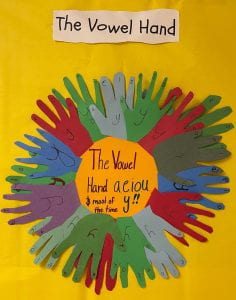How many times have you heard or uttered the phrase: “<a, e, i, o, u> & sometimes <y>”? Countless times I imagine.
Several of my elementary groups recently finished a quick holiday Vowel Hand wreath project by tracing their hand, writing each of the vowels on the fingers and a <y> on the palm of the Vowel Hand. This project was inspired by a post from Rebecca Loveless in the Structured Word Inquiry Facebook Group. She had posted a picture of a teacher’s Vowel Hand Wreath with that particular phrase written on it. Interestingly, she noted in her comments that it really should say “…most of the time <y>” to which several people agreed, including me.
When I showed the picture to my students so they could see what we were going to make with our cut-outs, they knew immediately that we would change the saying to “most of the time <y>” because we have said this dozens of times by this point in the year. A couple of students were curious about the use of two different phrases. They had seen plenty of examples of <y> functioning as a vowel far more often than they’d seen examples of <y> as a consonant. They wondered why anyone would say “sometimes <y>” when it was clear in our work, that it simply wasn’t the most logical choice. After discussing that sayings tend to sound catchy (they agreed that “sometimes <y> rolled off the tongue a bit better than “most of the time <y>) and that people tend to follow what they read in books or hear in their university classes or professional development. This saying has been around for decades, so we decided that people just went with it, didn’t think about questioning it. However, the students felt there was a more informative way to convey the job of <y> in our language. Continue reading

